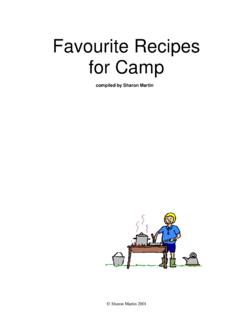Transcription of Serbian cookbook FINAL
1 Serbian COMMUNITY ASSOCIATION OF AUSTRALIA INC. Traditional SerbianTraditional SerbianTraditional SerbianTraditional Serbian RecipesRecipesRecipesRecipes cookbook For Aged Care Facilities First Edition Printed and Published June 2013 This Project, Increasing Awareness and Promoting Healthy Ageing in the Serbian Community, is supported by the Australian Government. Published by the Serbian Community Association of Australia Inc. SUMMARY This brochure was developed with the aim of providing an overview of Serbian culinary traditions and popular Serbian recipes which might be used in preparing meals for the Serbian elderly.
2 We hope it will be utilised by aged care facilities in order to deliver culturally appropriate meals to people of Serbian background. We would like to acknowledge the diversity of our culture and we should not assume that all the features outlined in the brochure would apply to everyone. Therefore, it is important to treat each Serbian as an individual and appreciate everyone s individuality. Serbian CUISINE Serbian cuisine is derived from mixed traditions mostly influenced by the neighbouring Mediterranean, especially Greek, Hungarian, Turkish, Bulgarian and Austrian cuisine which makes it a heterogeneous one.
3 Centuries of Austrian and Austro-Hungarian rule richly influenced Serbian cuisine, especially Serbian desserts. General Characteristics of the Cuisine: Crust white bread is essential and it is eaten at every meal A traditional Serbian welcome is to offer the guest just bread and salt Bread also plays an important role in religious rituals. Some people believe that it is sinful to throw away bread regardless of how old it is. Although pasta, rice, potato and similar side dishes did enter the everyday cuisine, many Serbs still eat bread with these meals. Vegetables are never just boiled or steamed and served.
4 They are often prepared with a sauce or fried with onion and garlic. Commonly eaten vegetables are potato (mashed, boiled or roasted), silver beet, cabbage, capsicum, beans, peas, sauerkraut, tomatoes, eggplant, pumpkin, cauliflower and corn. These vegetables are enjoyed cooked, as salads or relishes. Goulash is well liked, as are spiced meats. Soup is an important part of a main meal. Musakas, pastries and rice dishes are commonly eaten. Cornmeal dishes similar to polenta and pasta are also enjoyed. Salads are typically eaten with the main course and not as an appetizer for lunch. Fresh tomato sauce, olive oil, wine vinegar ,garlic, and onion are used commonly in cooking, as are paprika, dill, parsley, rosemary, basil and bay leaves.
5 Sweet deserts and cakes are frequently eaten. MEALS Most people in Serbia will have three meals daily, breakfast, lunch and dinner, with lunch being the largest in the Mediterranean fashion. BREAKFAST Breakfast in Serbia is an early but hearty meal, although before breakfast most people usually take a cup of coffee. Pastries or bread are served with butter, jam, yogurt, sour cream and cheese, accompanied by bacon, sausages, salami and scrambled eggs. Dishes made of polenta popular, with either tea, milk or yogurt being served at breakfastPopara Meal made with left over or fresh bread.
6 600 g homemade bread, baguettes or any crusty bread 100 g feta cheese or Mozzarella cheese 4 tsp of butter 500ml of water 500ml of milk salt to taste
7 Method: Take a bigger bowl and put together water, milk and salt to boil. When it start to boil add bread broken into pieces, reduce heat and cook till it softens up about 2-3min. Pour out extra water, you only need about 2cm above bread line. Continue cooking for further few minutes mixing it gently on occasion. Then, add cheese and mix through. Serve on a plate with a teaspoon of butter on top of it. Most people in Serbia will have three meals daily, breakfast, lunch and dinner, with lunch being the largest in the Mediterranean fashion.
8 Breakfast in Serbia is an early but hearty meal, although before breakfast . Pastries or bread are served with nied by bacon, ishes made of polenta are very at breakfast. salt to taste Then, add cheese and mix through. Proja Proja is a Serbian national dish of corn, known as corn breadGeneral recipe for proja : 5 cups corn flour 3 cups flour 3 eggs 3 cups oil 1 baking powder 1 cup yogurt 1 glass mineral water 1 big slice cheese - crushed salt Mix it all together and bake in greased pan until golden.
9 It shhigh. It is best served with sour cream or buttermilk. Serbian national dish of corn, known as corn bread. t should be 5 cm LUNCH SOUPS There are two types of soups in Serbian cuisine: standard soups called supa, and soups with roux (browned flour) - called orba. The most common are simple pottages made of beef or poultry with added noodles. Chicken broth soup 1kg - kg of chicken meat 2 onions cut in quarters 4 l of cold water 2 carrots (cut into large pieces) 2 celeries (stalks with leaves, root also can be used) 1 handful parsley Thyme, salt and pepper Preparation: 1.
10 Place the meat and onions in the bottom of a large cooking pot and dry fry (fry without oil or fat) for a little while, until it changes color. 2. Add water and stir well to mix up the sediment at the bottom of the pot. Heat it up to boiling. Use a spoon to skim off any impurities that rise to the surface. 3. Add all remaining ingredients, partially cover the pot and cook over medium heat for about 3 hours. 4. Strain and leave it to cool down. Removed meat and vegetables can be served as delicious lunch (or dinner). Place broth in the fridge. When completely cooled, a layer of fat will appear at the surface.




